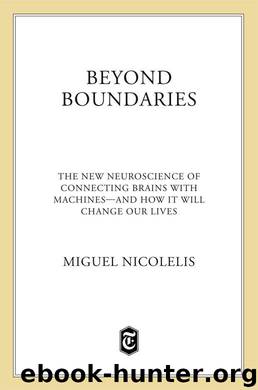Beyond Boundaries: The New Neuroscience of Connecting Brains with Machines---and How It Will Change Our Lives by Nicolelis Miguel

Author:Nicolelis, Miguel [Nicolelis, Miguel]
Language: eng
Format: epub
Publisher: Henry Holt and Co.
Published: 2011-03-15T05:00:00+00:00
FIGURE 7.3 Fine-tuning of cortical neurons that control the movements of the body and machines. Gray-scaled polar plots of the firing rate of one M1 neuron as a function of both arm velocity (key, top left) for different lags with respect to instant of instantaneous arm velocity measurement (0 ms). Velocity = 0 is at the center of each circle and maximum velocity (14 cms/second) is at the perimeter of the circle. Firing patterns were obtained during different modes of operation (pole control and brain control with and without hand movements), and during the use of different actuators (hand or robot movements, see legends). Each of the circles also encodes the neuron’s preferred direction (see scale). Gray shading indicates firing rate (minimum is white, maximum is dark gray). (A) A neighboring neuron that exhibits strong velocity and direction tuning only when the animal is using its hand to play the video game, but not the robot. (B) A single M1 neuron that displays both velocity and direction tuning during both pole and brain control and when the animal is using its hand or only the robot to play the video game. (C) A neighboring M1 neuron that exhibits enhanced velocity and direction (dashed arrows) tuning only when the monkey is preparing to use its brain activity to move the robot arm, but not when it moves its own biological arm. (Originally published in M. A. Lebedev, J. M. Carmena, J. E. O’Doherty, M. Zacksenhouse, C. S. Henriquez, J. Principe, and M.A.L. Nicolelis. “Cortical Ensemble Adaptation to Represent Velocity of an Artificial Actuator Controlled by a Brain Machine Interface.” Journal of Neuroscience 25 [2005]: 4681–93, with permission.)
Further analysis of the velocity and direction tuning curves revealed several interesting properties. First, we identified a population of cortical neurons that modulated their firing only when Aurora employed her own limb and hand to generate a movement (see Figure 7.3A). Invariably, these neurons exhibited clear and broad velocity and direction tuning prior to the onset of her arm movements. Often, both the velocity and direction tuning of these cells changed dynamically as the movement unfolded over time. Again, these dynamic changes resembled the flexibility of the spatiotemporal tactile receptive fields of the cortical and subcortical neurons recorded in our whisking rats a decade earlier. Second, once Aurora stopped making movements with her own arm, this group of cortical neurons stopped firing altogether. No action potential spikes were created. As a consequence, these neurons showed no velocity or direction tuning to the movements of the robot arm, despite the fact that these movements were actually under the control of Aurora’s brain (see Fig. 7.3A).
But this highly specific covariance of neuronal firing with biological arm movements was only one of the patterns that we were able to see within the electrical activity in Aurora’s cortex. Another sizable subset of her cortical neurons displayed velocity as well as direction tuning in response to movements of both her biological arm and the robot arm, even when Aurora was manipulating the BMI without making any muscle contractions (see Fig.
Download
This site does not store any files on its server. We only index and link to content provided by other sites. Please contact the content providers to delete copyright contents if any and email us, we'll remove relevant links or contents immediately.
| Automotive | Engineering |
| Transportation |
Whiskies Galore by Ian Buxton(41711)
Introduction to Aircraft Design (Cambridge Aerospace Series) by John P. Fielding(33011)
Small Unmanned Fixed-wing Aircraft Design by Andrew J. Keane Andras Sobester James P. Scanlan & András Sóbester & James P. Scanlan(32678)
Craft Beer for the Homebrewer by Michael Agnew(18074)
Turbulence by E. J. Noyes(7888)
The Complete Stick Figure Physics Tutorials by Allen Sarah(7258)
Kaplan MCAT General Chemistry Review by Kaplan(6812)
The Thirst by Nesbo Jo(6748)
Bad Blood by John Carreyrou(6468)
Modelling of Convective Heat and Mass Transfer in Rotating Flows by Igor V. Shevchuk(6349)
Learning SQL by Alan Beaulieu(6152)
Weapons of Math Destruction by Cathy O'Neil(6075)
Man-made Catastrophes and Risk Information Concealment by Dmitry Chernov & Didier Sornette(5870)
Digital Minimalism by Cal Newport;(5576)
Life 3.0: Being Human in the Age of Artificial Intelligence by Tegmark Max(5396)
iGen by Jean M. Twenge(5294)
Secrets of Antigravity Propulsion: Tesla, UFOs, and Classified Aerospace Technology by Ph.D. Paul A. Laviolette(5232)
Design of Trajectory Optimization Approach for Space Maneuver Vehicle Skip Entry Problems by Runqi Chai & Al Savvaris & Antonios Tsourdos & Senchun Chai(4949)
Electronic Devices & Circuits by Jacob Millman & Christos C. Halkias(4859)
